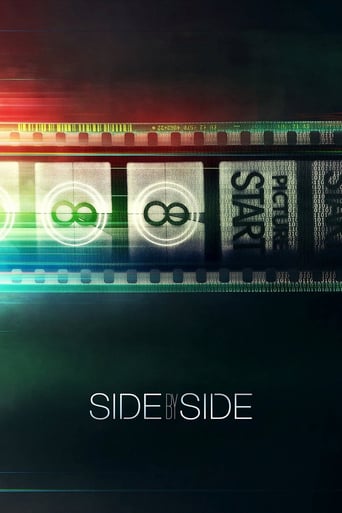cinswan
Christopher Kenneally, along with host Keanu Reeves and a myriad of directors and cinematographers interviewed for this film have done all of us in the creative arts, who find our tools and mediums altered by technology, a great service: they have described for us the benefits, detriments, and possible melding of past technologies with the new in the quest for achieving our goals of telling a story.As a writer, I do rely upon technology – the computer, the internet – in order to publish my works as e-books. Do I disdain Microsoft's default font as Times New Roman? (as a former phototypesetter who used Times English 49, yes, I do; and even that wasn't my preferred font – Palatino was the most beautiful font family to my eye). Spell and Grammar Check in Microsoft? It's my comedy explosion
the descent of standard American English into the realm of not knowing when to use "who" or "that" astounds me still. But I digress.This documentary, geeky and nerdy as it can be (and I love those things myself), shows how technology evolves to meet a creative need, is exploited to further meet a creative need, and how it also can fall short of the desired creative vision of those who use it. The film also serves as a history of how celluloid has been handled (and for a writer, this is so inspiring for me in terms of how to write), and how digital allows for visualizing people and events that otherwise would be difficult to achieve.From Scorsese's description of fingers being sliced in the process of physically splicing (cutting) celluloid to achieve the desired result, to the cinematographer on "Laurence of Arabia" describing how a celluloid film cut created a dramatic transition that no writer, director, or actor could have done alone gives great credit to a medium that is around a century old – and argues for the fact that because there is new digital technology, it doesn't render it obsolete. Quite the contrary: one director points out that, without a knowledge about how film photography renders a finished (in the rough) project, digital film photography can fall short of what the cinematic experience in full requires – the intuitive sensitivity of the eye, which is, at the core of it, a subjective interpretation of experience. And isn't all creativity that?The exploration of how digital technology expands ability to film at all (in difficult location circumstances) and in creating unknown worlds is just as fruitful to understand as the "10 minute cut" that the celluloid film canister requires. Actors and everyone else get to take a breath and come back to a scene anew, a great asset to the creative process. On the other hand, being able to continuously "film" someone in a challenging location without cuts also has advantages.In the final analysis, the title "Side by Side" says it all: both media are essential to the creative process when it comes to storytelling through a "film" media. Reeves' project underscores this by showing many examples of films shot on a variety of cameras. The cameras, back to geekdom, get center stage, as they should – the technology any of us use to create our work is vital to getting our work out to others.This film needs to be in the library of anyone in creative arts who finds that technology is impacting how they do what they do. On the one hand, "the better is the enemy of the good". On the other – new and old can walk forward side by side and expand the creative output of us all. As a writer contemplating having my work adapted for cable/streaming, I know that both technologies, and knowledge of them, will be essential to storytelling that will make the work memorable to all viewers.Isabeau Vollhardt, Author, The Casebook of Elisha Grey series
Andy Steel
The film goes in to quite a lot of technical detail about the technology of filmmaking; most was easy to follow, but I can see how it might put a few off. Some very interesting questions are posed; particularly revealing are the comments on the fad for 3D; something the studios seem to love at the moment. The music wasn't all it might have been as well; it sounded a little like I was watching an 80's infomercial about a film camera company at times. A well balanced piece although I did find it was beginning to drag a little towards the end. Still, well worth a look for any fan of the movies, I can't see it having a much broader appeal though. On a personal note; I don't really care what technology is used to make a film; to me the important thing is the story. Without a well scripted story, to my mind at least, there's no point in even starting.SteelMonster's verdict: RECOMMENDEDMy score: 8.2/10.You can find an expanded version of this review on my blog: Thoughts of a SteelMonster.
bob the moo
I tend to read proper film critics for their opinions not only on specific films but also essays on themes, genres, movements and so on; I consider myself a total amateur on such subjects but I find it interested to listen to those who are not. Coming to Side by Side I wasn't sure if it would be too dry for me to get into or if it would be too simplistic for me to stay interested in for just under two hours. The film essentially looks at the transition from celluloid to digital in film making – from filming through to post through to projection in the cinema and the means of delivery to the viewer. It is an ambitious goal but it is one that it does very well and in a way that flows and is accessible.I guess that for those with a real good working knowledge of the technology and the process, it may be too simplistic but for the casual viewer and enjoyer of films, there is enough detail here to engage and interest, but not so much that I felt overwhelmed with technical detail that I wasn't interested in. The film is really made up of Reeves acting as interviewer with a range of people involved in all the various aspects of the process – directors, cinematographers, editors, camera manufacturers etc. and he does a decent job, but not a great job in this regard. Fortunately this is not really his main role because it certainly seems that as producer he has helped Kenneally get a lot of very famous people to agree to be in the film. This range of talent and opinion makes for an interesting film, so while we follow development of things over time, we tend to get both sides as the title suggests.Most of the contributors are interesting and their soundbites are well edited and the film itself is put together very well so that it covers time and technology in a way that makes sense, engages and never outstays its welcome. It probably won't do much for the technical enthusiast but for fans of film and cinema it is very much worth seeing as entertainment and education.
KineticSeoul
If your one a film lover or just movie lover in general this documentary just might have your interest. This is actually a well crafted documentary that talks a bit about the history of film. Different cameras and about movies going 3D. But the primary focus is about the positive and negative aspects about films and digital. Although some of it can be individual directors or filmmakers opinions. It's interesting how it delves into the perception about authenticity and CGI in films today. While some filmmakers are focused on the authenticity of a film others think more about the digital age of making movies. And has no other than the cool and charismatic actor Keanu Reeves going around doing interviews for this documentary. And interview well known directors such as Martin Scorsese, Christopher Nolan, David Fincher, James Cameron, the Wachowski siblings and more. Although they share similar or different views on films and digital they all seem to show their love and passion for films or movies and what they do. For a film lover such as myself this documentary grabbed my attention and held my interest just about all the way through. Currently films in the movie making industry is disappearing and this documentary really does a good job of why it's sad to see something that has been around for such a long period of time from the beginning of movies leading to extinction. This is very good documentation about a form of entertainment and storytelling that will stay with a lot of people's memories and maybe within their hearts.9/10


 AD
AD

